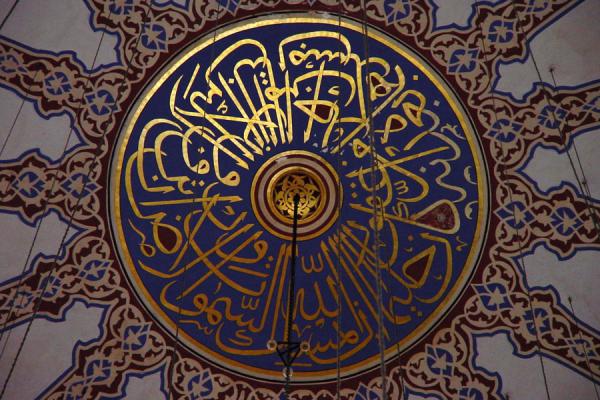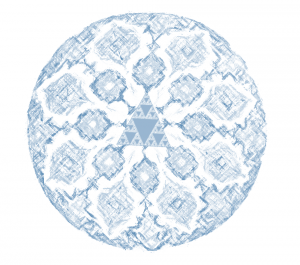Week 7: Bridal Symbolism in Islam
Poem by Sheikh Fareed (d. 1266):
Fareed, my withered body has become a skeleton; the crows are pecking at my palms.
Even now, God has not come to help me; behold, this is the fate of all mortal beings. ||90||
The crows have searched my skeleton, and eaten all my flesh.
But please do not touch these eyes; I hope to see my Lord. ||91||
O crow, do not peck at my skeleton; if you have landed on it, fly away.
Do not eat the flesh from that skeleton, within which my Husband Lord abides. ||92||
One light, one voice, emerges from the deep
Slowly, across the universe it begins to creep
One light, one voice, announces its presence
From the King of kings, to the lowest of peasants
One light, one voice, the search begins
Scholars and Saints examine all things
One light, one voice, hidden in plain sight
In brightest of day, in darkest of night
One light, one voice, the search goes on
From Allah to Buddha to dear St. John
One light, one voice, we must remember
And submit our will, to it we surrender
One light, one voice, one light, one voice
to it we return, to it we depart.
But my eyes cannot see, my ears cannot hear
I long, I wait, for that beloved I hold dear
Majnun, they call me, a madman I’m called
Where is Layla my light, by her I’m enthralled
There is no other purpose, no other pursuit
My body, it trembles, from my hat to my boot
One light, one voice, has stolen my soul
Now I must live, part empty, part hole.
In this week’s reading of Bridal Symbolism in the Ginans, by A. Asani, we read about how some interpretations of Islam discuss the idea of the bridal soul with the goal of reuniting with the husband (God). In the above poem, written by Sheikh Fareed, a Sufi mystic living in India around the 13th century, this idea is expressed through the poet’s desire to keep his eyes as the means by which to see the husband. Fareed is writing that he is dying as everyone is, but that he still desires for his soul to merge with his Husband. This concept connects a number of esoteric ideas in Islam. There is the light verse in the Quran, and specifically one interpretation of it which focuses on the idea of transmitting light through the prophets and the ability of the individual to gain that spiritual knowledge through their own soul. It is this type of interpretation that Fareed seems to agree with.
This particular poem is actually written in the Sikh scripture, which is how I came across it. The idea of God as the husband is a theme so ingrained in Sikhism that the poem read during the marriage ceremony is actually about the marriage of the two souls of the bride and groom with God instead of each other, mirroring the idea in the reading that many times poems about mystical love written by Persian poets are interpreted as being about earthy love. To me it was interesting to see the influence of the Sufi mystical interpretation of the soul in Sikhism and the inclusion of Muslim poetry in the scripture.
To capture some of the ideas and themes present in Fareed’s poem and in general love poetry, I wrote a short poem describing one light (God) as permeating existence. The reference to God as light is found throughout the Quran, but one particularly relevant verse is the Light Verse in which Allah is referred to as literally “the light of the heavens” (roughly translated to English). The one voice referenced in the poem also refers to God. In Islamic belief, God passed down the Quran orally to the Prophet so the voice and, in particular, the reciting of the Quran when done correctly is considered divine. As a result, the light and the voice are two very important concepts in Islam. The contrast between scholars and saints is also an important one because there has been a constant dispute through much of Islamic history on the correct approach to finding God: the rules and studies of the scholars or the mystical experiences and devotion of the saints. But in this poem, the two are considered equal in their pursuit of God, even though the general theme of the poem revolves around more of the mystical concept of love that the saints would support. Some of the more subtle ideas are the universality of God in Islam, as in the reference to Buddha and St. John and the idea of the King of Kings and the lowest of peasants sharing the same experience in this context.
The character in the poem is obsessed with finding some light, but is unable to do so because he is blind to its existence and so is cursed to remain forever longing to reunite with his beloved. I also used a reference to Majnun and Layla, two characters from a classic love story who loved each other, but were separated and died tragic deaths longing for each other in order to relate further to some of the metaphors Arab and Persian poets would use in their poems. In many poems, the boundary between a human lover and God is blurred as in this case. While Layla is the name of a fictional human woman, in this case, she is compared to a light (“Where is Layla, my light”) and the light may also refer to God, thus capturing the blur between love in a worldly context and in a spiritual context.




